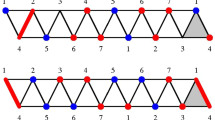Abstract
Certain simplicial complexes are used to construct a subset D of \(\mathbb {F}_{2^{n}}^{m}\) and D, in turn, defines the linear code CD over \(\mathbb {F}_{2^{n}}\) that consists of (v ⋅ d)d∈D for \(v\in \mathbb {F}_{2^{n}}^{m}\). Here we deal with the case n = 3, that is, when CD is an octanary code. We establish a relation between CD and its binary subfield code \(C_{D}^{(2)}\) with the help of a generator matrix. For a given length and dimension, a code is called distance optimal if it has the highest possible distance. With respect to the Griesmer bound, three infinite families of distance optimal codes are obtained, and sufficient conditions for certain linear codes to be minimal are established.
Similar content being viewed by others
Availability for supporting data
Not applicable.
References
Ashikhmin, A., Barg, A.: Minimal vectors in linear codes. IEEE Trans. Inf. Theory 44(5), 2010–2017 (1998)
Bonisoli, A.: Every equidistant linear code is a sequence of dual Hamming codes. Ars Combinatoria 18, 181–186 (1984)
Carlet, C., Ding, C., Yuan, J.: Linear codes from perfect nonlinear mappings and their secret sharing schemes. IEEE Trans. Inf. Theory 51(6), 2089–2102 (2005)
Chang, S., Hyun, J.Y.: Linear codes from simplicial complexes. Des Codes Cryptogr. 86(10), 2167–2181 (2018)
Chabanne, H., Cohen, G., Patey, A.: Towards secure two-party computation from the wire-tap channel. In: Lee, H.-S., Han, D.-G. (eds.) Proceeding of ICISC 2013 (Lecture Notes in Computer Science, Vol. 8565), pp 34–46. Springer, Berlin (2014)
Ding, C., Heng, Z.: The subfield codes of ovoid codes. IEEE Trans. Inf. Theory 65(8), 4715–4729 (2019)
Dinh, H.Q., Li, C., Yue, Q.: Recent progress on weight distributions of cyclic codes over finite fields. J. Algebra Comb. Disc. Struc. Appl. 2(1), 39–63 (2015)
Grassl, M.: Bounds on the minimum distance of linear codes. http://www.codetables.de, Accessed on November 18, 2022
Ding, K., Ding, C.: A class of two-weight and three-weight codes and their applications in secret sharing. IEEE Trans. Inf. Theory 61(11), 5835–5842 (2015)
Griesmer, J.H.: A bound for error correcting codes. IBM J. Res. Dev. 4(5), 532–542 (1960)
Huffman, W.C., Pless, V.: Fundamentals of Error-Correcting Codes. Cambridge University Press, Cambridge (2003)
Hyun, J.Y., Kim, H.K., Na, M.: Optimal non-projective linear codes constructed from down-sets. Discrete Appl. Math. 254, 135–145 (2019)
Hyun, J.Y., Kim, H.K., Wu, Y., Yue, Q.: Optimal minimal linear codes from posets. Des. Codes Cryptogr. 88(12), 2475–2492 (2020)
Hyun, J.Y., Lee, J., Lee, Y.: Infinite families of optimal linear codes constructed from simplicial complexes. IEEE Trans. Inf. Theory 66(11), 6762–6773 (2020)
Kløve, T.: Codes for Error Detection. World Scientific, Hackensack (2007)
Massey, J.L.: Minimal codewords and secret sharing. In: Proc. 6th Joint Swedish-Russian Int. Workshop on Info. Theory, pp. 276–279 (1993)
Shamir, A.: How to share a secret. Commun. ACM 22(11), 612–613 (1979)
Wu, Y., Li, C., Xiao, F.: Quaternary linear codes and related binary subfield codes. IEEE Trans. Inf. Theory 68(5), 3070–3080 (2022)
Wu, Y., Lee, Y.: Binary LCD codes and self-orthogonal codes via simplicial complexes. IEEE Commun. Lett. 24(6), 1159–1162 (2020)
Yuan, J., Ding, C.: Secret sharing schemes from three classes of linear codes. IEEE Trans. Inf. Theory 52(1), 206–212 (2006)
Zhu, X., Wei, Y.: Few-weight quaternary codes via simplicial complexes. AIMS Math. 6(5), 5124–5132 (2021)
Acknowledgements
The authors would like to thank the anonymous referees for their valuable comments and suggestions. The authors also would like to thank the handling editor of the journal for the time spent during the whole process.
Funding
Not applicable.
Author information
Authors and Affiliations
Contributions
Vidya Sagar and Ritumoni Sarma contributed equally to this work. Both authors read and approved the final manuscript.
Corresponding author
Ethics declarations
Ethics approval and consent to participate
Not applicable.
Consent for Publication
Not applicable.
Competing interests
The authors declare that they have no competing interests.
Additional information
Publisher’s note
Springer Nature remains neutral with regard to jurisdictional claims in published maps and institutional affiliations.
Rights and permissions
Springer Nature or its licensor (e.g. a society or other partner) holds exclusive rights to this article under a publishing agreement with the author(s) or other rightsholder(s); author self-archiving of the accepted manuscript version of this article is solely governed by the terms of such publishing agreement and applicable law.
About this article
Cite this article
Sagar, V., Sarma, R. Octanary linear codes using simplicial complexes. Cryptogr. Commun. 15, 599–616 (2023). https://doi.org/10.1007/s12095-022-00617-z
Received:
Accepted:
Published:
Issue Date:
DOI: https://doi.org/10.1007/s12095-022-00617-z



